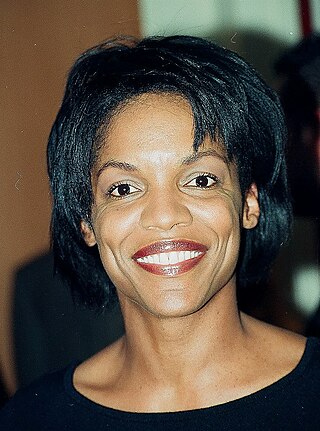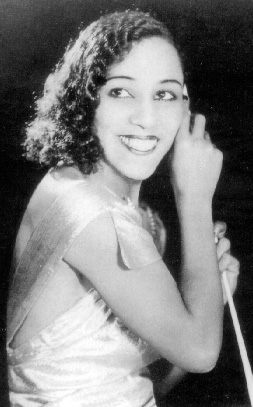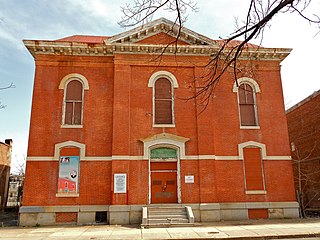Related Research Articles

James Hubert "Eubie" Blake was an American pianist and composer of ragtime, jazz, and popular music. In 1921, he and his long-time collaborator Noble Sissle wrote Shuffle Along, one of the first Broadway musicals written and directed by African Americans. Blake's compositions included such hits as "Bandana Days", "Charleston Rag", "Love Will Find a Way", "Memories of You" and "I'm Just Wild About Harry". The 1978 Broadway musical Eubie! showcased his works, and in 1981, President Ronald Reagan awarded Blake the Presidential Medal of Freedom.

Cabell Calloway III was an American jazz singer and bandleader. He was a regular performer at the Cotton Club in Harlem, where he became a popular vocalist of the swing era. His niche of mixing jazz and vaudeville won him acclaim during a career that spanned over 65 years.

Noble Lee Sissle was an American jazz composer, lyricist, bandleader, singer, and playwright, best known for the Broadway musical Shuffle Along (1921), and its hit song "I'm Just Wild About Harry".
The music of Baltimore, the largest city in Maryland, can be documented as far back as 1784, and the city has become a regional center for Western classical music and jazz. Early Baltimore was home to popular opera and musical theatre, and an important part of the music of Maryland, while the city also hosted several major music publishing firms until well into the 19th century, when Baltimore also saw the rise of native musical instrument manufacturing, specifically pianos and woodwind instruments. African American music existed in Baltimore during the colonial era, and the city was home to vibrant black musical life by the 1860s. Baltimore's African American heritage to the start of the 20th century included ragtime and gospel music. By the end of that century, Baltimore jazz had become a well-recognized scene among jazz fans, and produced a number of local performers to gain national reputations. The city was a major stop on the African American East Coast touring circuit, and it remains a popular regional draw for live performances. Baltimore has produced a wide range of modern rock, punk and metal bands and several indie labels catering to a variety of audiences.

Nnenna Freelon is an American jazz singer, composer, producer, and arranger.

Fanny Jackson Coppin was an American educator, missionary and lifelong advocate for female higher education. One of the first Black alumnae of Oberlin College, she served as principal of the Institute for Colored Youth in Philadelphia and became the first African American school superintendent in the United States.

Upton is a neighborhood in Baltimore City, Maryland, United States. The neighborhood is in the western section of the city, roughly between Fremont Avenue and McCulloh Street, extending from Dolphin Street to Bloom Street. Its principal thoroughfare is Pennsylvania Avenue.

Blanche Dorothea Jones Calloway was an American jazz singer, composer, and bandleader. She was the older sister of Cab Calloway and was a successful singer before her brother. With a music career that spanned over fifty years, Calloway was the first woman to lead an all-male orchestra and performed alongside musicians such as Cozy Cole, Chick Webb, and her brother. Her performing style was described as flamboyant and a major influence on her brother's performance style.

Frederick Douglass High School, established in 1883, is an American public high school in the Baltimore City Public Schools district. Originally named the Colored High and Training School, Douglass is the second-oldest U.S. high school created specifically for African American students. Prior to desegregation, Douglass and Paul Laurence Dunbar High School were the only two high schools in Baltimore that admitted African-American students, with Douglass serving students from West Baltimore and Dunbar serving students from East Baltimore.
Carl Murphy was an African-American journalist, publisher, civil rights leader, and educator. He was publisher of the Afro-American newspaper chain of Baltimore, Maryland, expanding its coverage with regional editions in several major cities of the Washington, D.C., area, as well as Newark, New Jersey, a destination of thousands of rural blacks in the Great Migration to the North.
Burgundy Farm Country Day School is an independent school on a 25-acre (100,000 m2) campus in the Rose Hill census-designated place of Fairfax County, Virginia, with an Alexandria postal address, and 611 acres (2.47 km2) in West Virginia. It serves students in grades Junior Kindergarten through Eighth Grade.

That's Black Entertainment is a 1989 documentary film starring African-American performers and featuring clips from black films from 1929–1957, narrated and directed by William Greaves. The clips are from the Black Cinema Collection of the Southwest Film/Video Archives at Southern Methodist University in Dallas, Texas. It is 60 minutes long and was distributed by Video Communications of Tulsa, Oklahoma.

Old West Baltimore Historic District is a national historic district in Baltimore, Maryland, United States. It is primarily a row house neighborhood of approximately 175 city blocks directly northwest of downtown Baltimore. The district includes other housing from grand mansions to alley houses, as well as churches, public buildings, commercial buildings, and landscaped squares. Pennsylvania Avenue, the main street of the community, features a later 20th century municipal market house. Within the district are civic monuments that relate to Baltimore's premier historic African-American community. Such noteworthy figures as Supreme Court Justice Thurgood Marshall, Congressman Parren Mitchell, jazz artist Cab Calloway, civil rights leader Lillie Mae Carroll Jackson, and Carl Murphy, editor of the Baltimore Afro-American newspaper, lived and / or worked in the area.

John Henry Murphy III, was a publisher and newspaper executive, head of the family-owned enterprise of the Afro-American newspaper based in Baltimore, Maryland. At its peak, it had nine national editions, published in 13 major cities. Murphy was the grandson of the paper's founder, former slave and Civil War veteran John H. Murphy Sr. After working from 1937 as manager of the paper's Washington, D.C., edition, and in other positions, Murphy succeeded his uncle Carl J. Murphy in 1967 as president of the Afro-American papers, and in 1974 as chairman of the board and publisher.
The history of African Americans in Maryland is long and complex. Southern Maryland is the home of the first person of African descent to be elected to and serve in a legislature in America. His name was Mathias de Sousa and he was one of the original colonists to arrive in 1634. Southern Maryland is also the place where Josiah Henson was enslaved, and the place of brutality he wrote about in his later autobiography, which became the basis for Harriet Beecher Stowe's "Uncle Tom's Cabin".

Paul Samuel Henderson was an African-American photojournalist for the Baltimore Afro-American newspaper from 1929 through c. 1960. He became well known for taking pictures of large groups and distant objects atop a ladder he carried. Henderson primarily photographed people, including church groups, politicians, graduations, local college and university groups, weddings, events during the Civil Rights Movement, and more. He was a member of the National Association for the Advancement of Colored People, a vestryman at St. James Church, charter member of the Druid Hill Avenue Neighborhood Club, assistant treasurer of a local Frontiers International club, and supported The Salvation Army.
Marie Johnson-Calloway was an American artist. She was born in Pimlico, Baltimore, Maryland to Sidney Edwards and Marie Edwards. She worked in the fields of painting and mixed-media assemblage.
Rozeal is a contemporary American artist known for her colourful and complex cross cultural painting technique. She best known for her narrative canvases commenting on cultural, racial and sexual identity. A large part of her work touches on the differences between appropriation and appreciation. Ultimately, Rozeals work and portrayal of pornographic prints illustrates a set of politically powerful messages.
Emmelyne Kemp is an American pianist, vocalist, bandleader, Broadway composer, lecturer, and music researcher. She is a protégé of Eubie Blake. She is best known as a Broadway composer for Bubbling Brown Sugar. She is also known as a singer in the Woody Allen film Sweet and Lowdown. She has performed throughout the United States, Germany and Japan.
Plantation Days (1922) was a touring musical revue with Sam Wooding and James P. Johnson as musical directors at different stages of the tour. Produced by Morris "Maury" Greenwald, the touring show was conceived to capitalize on Plantation Revue (1922-23), the successful show staged by Lew Leslie.
References
- 1 2 3 4 5 6 7 8 Hong, Peter; Hughes, Leonard (June 17, 1993). "A Long Career of Opening Young Minds". Washington Post. ISSN 0190-8286.
- 1 2 Zurawik, David (February 27, 2012). "PBS treats Baltimore's Cab Calloway as an American Master". The Baltimore Sun.
- 1 2 3 4 5 Effros, Barbara (September 1, 2016). "Chris Calloway Brooks Keeps the "Hi-De-Ho" in the Family". The Syncopated Times.
- ↑ Gates (Jr.), Henry Louis; Higginbotham, Evelyn Brooks (2009). Harlem Renaissance Lives from the African American National Biography. Oxford University Press. p. 98. ISBN 978-0-19-538795-7.
- 1 2 3 Pryor-Trusty, Rosa (2013). African-American Community, History & Entertainment in Maryland. Xlibris Corporation. p. 402. ISBN 978-1-4836-1234-8.
- ↑ Remesch, Karin (December 13, 1998). "Eubie Blake National Jazz Institute and Cultural Center". The Baltimore Sun.
- ↑ "Cab's Grandson". Jet: 58. October 20, 1955.
- ↑ Rao, Sameer (December 13, 2019). "Could little-known civil rights history save Cab Calloway's Druid Heights house? Some supporters think so". The Baltimore Sun.
- ↑ "Gerri Major's Society World: Cocktail Chitchat". Jet: 38. March 13, 1980.
- ↑ Prince, Zenitha (October 17, 2010). "AFRO mourns loss of former leader, John H. Murphy III | Afro". The Afro-American.